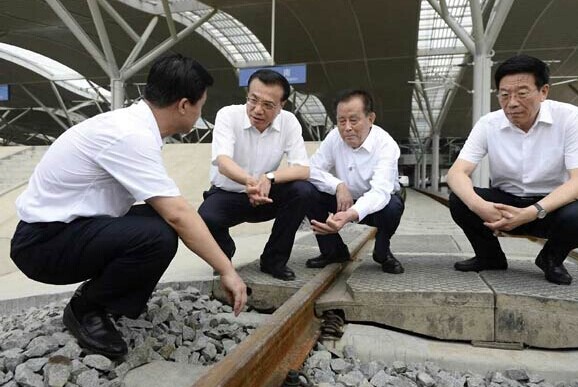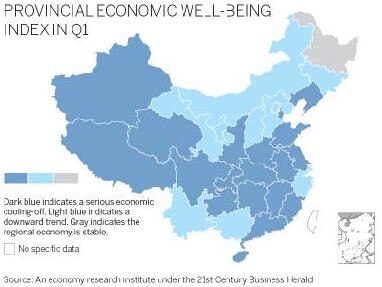

Premier Li Keqiang (second from left) pays an inspection visit to the construction site of the Shanghai-Kunming high-speed railway in Changsha, Hunan province, on Thursday. LIU ZHEN/CHINA NEWS SERVICE

Fact-finding visit is signaling area as growth engine for entire nation, analysts say
Premier Li Keqiang arrived in Changsha, capital of Central China's Hunan province, on Thursday, to take the pulse of the economy at midyear and propose steps to maintain growth.
The trip took Li to the construction site of a high-speed railway as well as a local university, where he enjoyed some light moments with workers and students.
The meetings were a stark contrast to the atmosphere at an economic symposium held afterward, where Li heard the worries of provincial governors and corporate leaders.
It is a convention for Chinese premiers to conduct field visits in early July ahead of the release of half-year economic indicators. So local governors and business owners were watching closely for clues about where the premier will take the nation's economic policies.
Experts said his choice of a destination reveals the answer. The potential resilience of China's economy lies not on the coastline but more in the central area of the country, where urbanization is just getting started, the infrastructure needs upgrading, and robust growth is expected.
According to an index compiled by the research institute of the 21st Century Business Herald, the economic well-being of central provinces led the nation in the first quarter of this year.
The index gives industrial output a 30 percent weighting, fixed-asset investment 20 percent and three other indicators 10 percent each. The result was that the central provinces have the greatest potential for development.
Hubei province in Central China topped the list. Four other central provinces also appeared in the top 10: Henan, Hunan, Jiangxi and Anhui.
Northeast provinces - Heilongjiang, for instance - ranked at the low end of the scale. These old industrial bases are finding their restructuring to be a challenging task.
Zhang Keyun, a regional economics professor at Renmin University of China, said the central area faces fewer challenges in industrial restructuring than coastal China while being equipped with better public facilities and a more favorable investment environment than the west.
In addition, most of the central provinces are also important grain producers. That's another key factor in their high level of well-being.
"Agriculture should not be regarded as an obstacle to development. Instead, the development of modern agriculture, which involves construction of facilities and investment in agricultural equipment, holds high potential for local economies," Zhang said.
He said that at present, growth in the central area is largely driven by an increase in investment, so looking at the long term, there's a need for the restructuring of heavy industry and the chemical sector.
"The development of the central provinces won't occur in isolation. It will drive the surrounding area and become an economic engine of China," he said.
Premier Li Keqiang visited a construction site for a high-speed railway line in Changsha, Hunan province, on Thursday morning and chatted with workers there.
The construction site is close to the Changsha South Railway Station.
Changsha will be part of a new line linking Shanghai and Kunming, with its 2,264-kilometer length making it the longest rail line between east and west China. Completion is scheduled for 2016.
The service will save 28 hours for passengers traveling between Shanghai and Kunming.
Li told the workers they were making a significant contribution to the country's development and praised their careers as "remarkable".
The line will pass through several poverty-stricken areas in central and western China. Li told the project managers that the construction of railways should be based on economic benefits as well as social justice.
The new line will help impoverished farmers from remote mountainous regions travel to cities for work and higher incomes, Li added.
Li said the high-speed line will help narrow the economic gap between the country's eastern and western regions and reduce the emotional distance between people in the disparate regions.
He also praised the construction company's efforts to promote rail products and equipment abroad.
More than 291.8 billion yuan ($46.9 billion) will be invested in the project, excluding the cost of the Shanghai-Hangzhou section, which was put into service in 2010.
Li visits builders of high-speed rail
2014-07-04Help growth efforts, Li tells officials
2014-06-07Premier Li promises stabilized growth
2014-05-29Li confident over economic growth
2014-01-22Premier Li promises reasonable growth rate
2013-11-08China‘s Q2 GDP to grow 7.5 pct: report
2014-07-03BoCom predicts China‘s 2014 GDP growth at 7.5 pct
2014-07-03Copyright ©1999-2018
Chinanews.com. All rights reserved.
Reproduction in whole or in part without permission is prohibited.